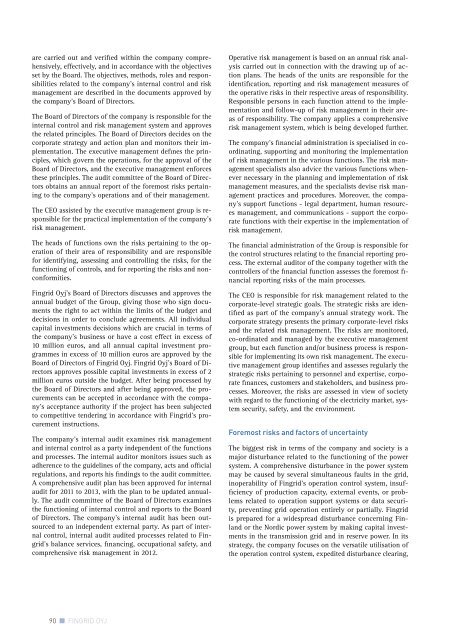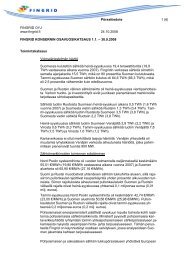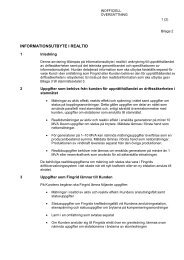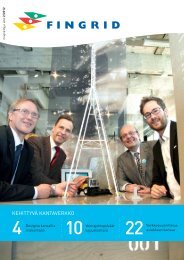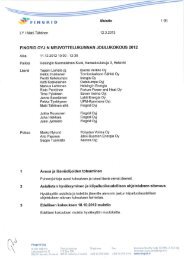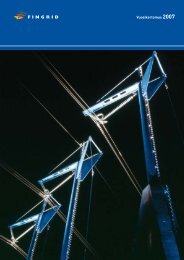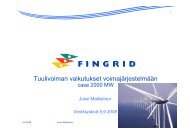Annual Report 2012 - Fingrid
Annual Report 2012 - Fingrid
Annual Report 2012 - Fingrid
You also want an ePaper? Increase the reach of your titles
YUMPU automatically turns print PDFs into web optimized ePapers that Google loves.
are carried out and verified within the company comprehensively,<br />
effectively, and in accordance with the objectives<br />
set by the Board. The objectives, methods, roles and responsibilities<br />
related to the company’s internal control and risk<br />
management are described in the documents approved by<br />
the company’s Board of Directors.<br />
The Board of Directors of the company is responsible for the<br />
internal control and risk management system and approves<br />
the related principles. The Board of Directors decides on the<br />
corporate strategy and action plan and monitors their implementation.<br />
The executive management defines the principles,<br />
which govern the operations, for the approval of the<br />
Board of Directors, and the executive management enforces<br />
these principles. The audit committee of the Board of Directors<br />
obtains an annual report of the foremost risks pertaining<br />
to the company’s operations and of their management.<br />
The CEO assisted by the executive management group is responsible<br />
for the practical implementation of the company’s<br />
risk management.<br />
The heads of functions own the risks pertaining to the operation<br />
of their area of responsibility and are responsible<br />
for identifying, assessing and controlling the risks, for the<br />
functioning of controls, and for reporting the risks and nonconformities.<br />
<strong>Fingrid</strong> Oyj’s Board of Directors discusses and approves the<br />
annual budget of the Group, giving those who sign documents<br />
the right to act within the limits of the budget and<br />
decisions in order to conclude agreements. All individual<br />
capital investments decisions which are crucial in terms of<br />
the company’s business or have a cost effect in excess of<br />
10 million euros, and all annual capital investment programmes<br />
in excess of 10 million euros are approved by the<br />
Board of Directors of <strong>Fingrid</strong> Oyj. <strong>Fingrid</strong> Oyj’s Board of Directors<br />
approves possible capital investments in excess of 2<br />
million euros outside the budget. After being processed by<br />
the Board of Directors and after being approved, the procurements<br />
can be accepted in accordance with the company’s<br />
acceptance authority if the project has been subjected<br />
to competitive tendering in accordance with <strong>Fingrid</strong>’s procurement<br />
instructions.<br />
The company’s internal audit examines risk management<br />
and internal control as a party independent of the functions<br />
and processes. The internal auditor monitors issues such as<br />
adherence to the guidelines of the company, acts and official<br />
regulations, and reports his findings to the audit committee.<br />
A comprehensive audit plan has been approved for internal<br />
audit for 2011 to 2013, with the plan to be updated annually.<br />
The audit committee of the Board of Directors examines<br />
the functioning of internal control and reports to the Board<br />
of Directors. The company’s internal audit has been outsourced<br />
to an independent external party. As part of internal<br />
control, internal audit audited processes related to <strong>Fingrid</strong>’s<br />
balance services, financing, occupational safety, and<br />
comprehensive risk management in <strong>2012</strong>.<br />
Operative risk management is based on an annual risk analysis<br />
carried out in connection with the drawing up of action<br />
plans. The heads of the units are responsible for the<br />
identification, reporting and risk management measures of<br />
the operative risks in their respective areas of responsibility.<br />
Responsible persons in each function attend to the implementation<br />
and follow-up of risk management in their areas<br />
of responsibility. The company applies a comprehensive<br />
risk management system, which is being developed further.<br />
The company’s financial administration is specialised in coordinating,<br />
supporting and monitoring the implementation<br />
of risk management in the various functions. The risk management<br />
specialists also advice the various functions whenever<br />
necessary in the planning and implementation of risk<br />
management measures, and the specialists devise risk management<br />
practices and procedures. Moreover, the company’s<br />
support functions - legal department, human resources<br />
management, and communications - support the corporate<br />
functions with their expertise in the implementation of<br />
risk management.<br />
The financial administration of the Group is responsible for<br />
the control structures relating to the financial reporting process.<br />
The external auditor of the company together with the<br />
controllers of the financial function assesses the foremost financial<br />
reporting risks of the main processes.<br />
The CEO is responsible for risk management related to the<br />
corporate-level strategic goals. The strategic risks are identified<br />
as part of the company’s annual strategy work. The<br />
corporate strategy presents the primary corporate-level risks<br />
and the related risk management. The risks are monitored,<br />
co-ordinated and managed by the executive management<br />
group, but each function and/or business process is responsible<br />
for implementing its own risk management. The executive<br />
management group identifies and assesses regularly the<br />
strategic risks pertaining to personnel and expertise, corporate<br />
finances, customers and stakeholders, and business processes.<br />
Moreover, the risks are assessed in view of society<br />
with regard to the functioning of the electricity market, system<br />
security, safety, and the environment.<br />
Foremost risks and factors of uncertainty<br />
The biggest risk in terms of the company and society is a<br />
major disturbance related to the functioning of the power<br />
system. A comprehensive disturbance in the power system<br />
may be caused by several simultaneous faults in the grid,<br />
inoperability of <strong>Fingrid</strong>’s operation control system, insufficiency<br />
of production capacity, external events, or problems<br />
related to operation support systems or data security,<br />
preventing grid operation entirely or partially. <strong>Fingrid</strong><br />
is prepared for a widespread disturbance concerning Finland<br />
or the Nordic power system by making capital investments<br />
in the transmission grid and in reserve power. In its<br />
strategy, the company focuses on the versatile utilisation of<br />
the operation control system, expedited disturbance clearing,<br />
90 FINGRID OYJ


